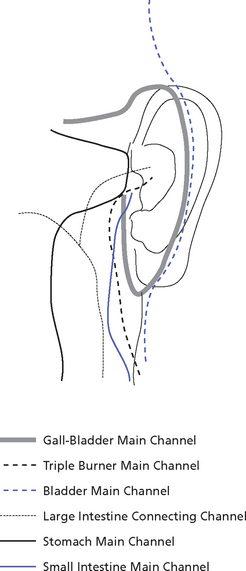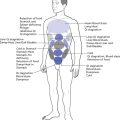 OBSERVATION OF THE EARS
OBSERVATION OF THE EARS
INTRODUCTION
The ears are related to the Kidneys. Chapter 17 of the ‘Spiritual Axis’ says: ‘Kidney-Qi opens into the ears, when the Kidneys are harmonized the ears can detect the five sounds.’1 Chapter 5 of the ‘Simple Questions’ says: ‘The Kidneys govern the ears.’2 Chapter 37 of the ‘Spiritual Axis’ says: ‘The ears are the sense organ of the Kidneys.’3 Although the relationship between the ears and the Kidneys is very strong, other organs also influence the ears. For example, the Heart has an influence on the physiology and pathology of the ear. Chapter 4 of the ‘Simple Questions’ says: ‘The South corresponds to the colour red and to the Heart which opens into the ear.’4
CHANNELS INFLUENCING THE EARS
The pathways of the channels flowing to the ears are summarized in Box 9.1 and illustrated in Figure 9.1.

Fig. 9.1 Channels flowing to the ears
The normal ear should be first of all proportionate in size to the head, it should be relatively moist, its flesh should be full but supple and the helix should be pale red and moist.
For a more detailed description of the patterns appearing in symptoms and signs related to the ears, see Chapter 57.
EAR SIZE
Swollen ears
Symptoms and Signs, Chapter 57
Swollen ears are generally due to Heat or Damp-Heat, which may derive from various organs but particularly from the Gall-Bladder. (See Plate 9.1 on p. P8.) Another possible cause of swollen ears is invasion of Wind-Water in the Lungs.
ABNORMAL COLOUR
Red helix
Symptoms and Signs, Chapter 57
A red helix generally indicates Heat, especially of the Heart or Lungs, or both; it may also indicate Heat in the Lesser-Yang channels or Damp-Heat in the Liver and Gall-Bladder. A floating, red colour of the helix is due to Kidney-Yin deficiency with Empty-Heat. (See Plate 9.2 on p. P8.)
DISCHARGE FROM THE EARS
Symptoms and Signs, Chapter 57
Box 9.2 summarizes the patterns underlying ear discharge.
NOTES
1. The Yellow Emperor’s Classic of Internal Medicine – Spiritual Axis (Ling Shu Jing  ). People’s Health Publishing House: Beijing, 1981:50 First published c. 100BC
). People’s Health Publishing House: Beijing, 1981:50 First published c. 100BC
2. The Yellow Emperor’s Classic of Internal Medicine – Simple Questions (Huang Di Nei Jing Su Wen  ). People’s Health Publishing House: Beijing, 1979:41 First published c. 100BC
). People’s Health Publishing House: Beijing, 1979:41 First published c. 100BC



